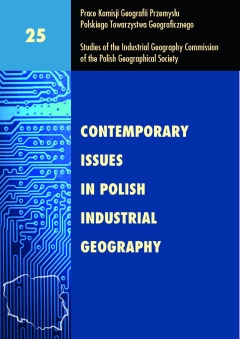Contemporary Trends in the Development of the Pharmaceutical Industry in the World
DOI:
https://doi.org/10.24917/20801653.25.6Keywords:
BRIC, clinical trials, pharmaceutical industry, relocation, USAAbstract
The pharmaceutical industry remains today a prominent high-technology sector of the economy,and consistently maintains its competitiveness on the world market at a very high level. Similarly to aircraft and spacecraft manufacturing and the electro-energy industry, pharmaceutical industry belongs to a group of innovative high-technology industries, which are based on scientific research results processed for industrial activities. The purpose of this study is to present and analyse global trends currently observed in the pharmaceutical industry in the world. In an era of increasing globalization, new prime movers of the development of the pharmaceutical industry are the countries from peripheralregions, mainly members of the BRICS group. For this reason, this article focuses on the emerging Asian and Latin American markets, next to the United States and countries of Western Europe. At the beginning of the twenty-first century, Brazil and China deemed the stimulation of the pharmaceutical industry one of the prime determinants of their future economic development. The following paper at first presents characteristics of the pharmaceutical industry products: innovative and generic medicines, medications available without prescription, biological agents, biosimilars and pharmaceutical substrates. Furthermore, the author specifies the properties and rates the dynamics of changes that are taking place in the global pharmaceutical market, while explaining the specifics of the relocation of the pharmaceutical industry. By comparing the number of publications in the field of pharmacy in selected countries of the world, the author confirmed the increasing importance of this industry on the global economy. In the last part of the article, the author presents the structure, number and distribution of clinical trials on a global scale. To illustrate the trends currently taking place in the development of the pharmaceutical industry, the author used raw statistical data in the field of pharmacology and literature on the subject.Downloads
Metrics
References
Calo-Fernández, B., Martínez-Hurtado, J. (2012). Biosimilars: Company Strategies to Capture Value from the Biologics Market. Pharmaceuticals, 5(12), 1393–1408. DOI: 10.3390/ph5121393.
Dorocki, S., Jastrzębski, J. (2012). Regionalne zróżnicowanie rozwoju biotechnologii w Europie. Prace Komisji Geografii Przemysłu Polskiego Towarzystwa Geograficznego, 20, 67–94.
Dorocki, S., Świętek, A. (2013). Uwarunkowania rozwoju usług opartych na wiedzy, na przykładzie analizy działalności gabinetów stomatologicznych w Polsce. Prace Komisji Geografii Przemysłu Polskiego Towarzystwa Geograficznego, 21, 348–365.
Gierańczyk, W., Rachwał, T. (2012). Structural changes in the industry of Poland against the background of eastern European Union states. Quaestiones Geographicae, 31(2), 83–93.
Herper, M. (2013). The Cost of Creating A New Drug Now $5 Billion, Pushing Big Pharma To Change. Retrieved from http://www.forbes.com/sites/matthewherper/2013/08/11/how-the-staggering-cost- of-inventing-new-drugs-is-shaping-the-future-of-medicine/.
Herper, M. (2013). How Much Does Pharmaceutical Innovation Cost? A Look At 100 Companies. Retrieved from Forbes, 2013/08/11. Retrieved from http://www.forbes.com/sites/matthewherper/ 2013/08/11/the-cost-of-inventing-a-new-drug-98-companies-ranked/.
Higgins, M.J., Rodriguez, D. (2006). The outsourcing of R&D through acquisitions in the pharmaceutical industry. Journal of Financial Economics, 80(2), 351–383. DOI: 10.1016/j.jfineco. 2005.04.004.
Howells, J., Gagliardi, D., Malik, K. (2008). The growth and management of R&D outsourcing: evidence from UK pharmaceuticals. R&D Management, 38, 205–219. DOI: 10.1111/j.1467-9310.2008.00508.x.
Kaplan, W.A., Wirtz, V.J., Stephens, P. (2013). The Market Dynamics of Generic Medicines in the Private Sector of 19 Low and Middle Income Countries between 2001 and 2011: A Descriptive Time Series Analysis. PLoS ONE, 8(9): e74399. DOI:10.1371/journal.pone.0074399.
Kilar, W. (2008). Zatrudnienie w działalności badawczej i rozwojowej jako czynnik rozwoju gospodarki opartej o wiedzę. Przedsiębiorczość – Edukacja, 4, 60–69.
Kilar, W. (2009). Koncentracja przestrzenna światowych firm informatycznych. Prace Komisji Geografii Przemysłu Polskiego Towarzystwa Geograficznego, 12, 97–108.
Kwanghui, L. (2004). The relationship between research and innovation in the semiconductor and pharmaceutical industries (1981–1997). Research Policy, 33, 287–321.
Malorye, A. (2012). Reinventing clinical trials. Nature Biotechnology, 30, 41–49. DOI:10.1038/ nbt.2083.
McCamish, M., Woollett, G. (2012). The State of the Art in the Development of Biosimilars. Clinical Pharmacology & Therapeutics, 91(3), 405–417. DOI:10.1038/clpt.2011.343.
Morgan, S.G. (2006). Prescription Drug Expenditures and Population Demographics. Health Services Research, 41(2), 411–428. DOI: 10.1111/j.1475-6773.2005.00495.x.
Pharmaceuticals & Biotech Industry Global Report – 2011. IMAP Healthcare Report.
Rachwał, T. (2003). Globalne uwarunkowania restrukturyzacji przedsiębiorstw Polski Południowo- Wschodniej. Prace Komisji Geografii Przemysłu Polskiego Towarzystwa Geograficznego, 6, 129–138.
Rachwał, T. (2013). Rola przedsiębiorstw przemysłowych w rozwoju gospodarki opartej na wiedzy. Prace Komisji Geografii Przemysłu Polskiego Towarzystwa Geograficznego, 21, 189–211.
Raźniak, P. (2012). Procesy społeczno-ekonomiczne w Krakowskim Obszarze Metropolitalnym. Prace Geograficzne, 129, 63–81.
Raźniak, P. (2013). Zależność pomiędzy miejscem w międzynarodowych hierarchiach miast a poziomem usług turystycznych. Prace Komisji Geografii Przemysłu Polskiego Towarzystwa Geograficznego, 24, 76–90.
Research and Development in the Pharmaceutical Industry. (2006). The Congress of the United States.
Scannell, J.W., Blanckley, A., Boldon, H., Warrington B. (2010). Diagnosing the decline in pharmaceutical R&D efficiency. Nature Reviews Drug Discovery, 11, 191–200. DOI:10.1038/nrd3681.
Schipper, I., Weyzig, F. (2008). Ethics for Drug Testing in Low and Middle Income Countries. Considerations for European Market Authorisation. Amsterdam: SOMO.
Schipper, I. (2009). Clinical Trials in Developing Countries. Brussels: European Parliament.
Somnath, P. (2013) Shifts in the Generic-Drug Market: Trends and Causes. U.S. Pharmacist, 38(6) (Generic Drug Review suppl.), 6–10.
Tobolska, A., Matykowski, R. (2006). Działalność przemysłowa w warunkach wzrastającej internacjonalizacji i globalizacji na przykładzie wybranych produktów. Prace Komisji Geografii Przemysłu Polskiego Towarzystwa Geograficznego, 8, 47–59.
Toole, A. (2012). The Impact of Public Basic Research on Industrial Innovation: Evidence from the Pharmaceutical Industry. Research Policy 41(1), 1–12. DOI: 10.1016/j.respol.2011.06.004.
Vogler, S., Zimmermann, N., Leopold, C., de Joncheere, K. (2011). Pharmaceutical policies in European countries in response to the global financial crisis. Southern Med Review, 4(2), 69–79. DOI: 10.5655/smr.v4i2.1004.
Weyzig, F. (2004). Sector profile of the pharmaceutical industry. Amsterdam: SOMO.
Zioło, Z. (2006). Zróżnicowanie światowej przestrzeni przemysłowej w świetle koncentracji siedzib zarządów wiodących korporacji. Prace Komisji Geografii Przemysłu Polskiego Towarzystwa Geograficznego, 8, 9–26.
Downloads
Published
How to Cite
Issue
Section
License
Articles are published under the terms of the Creative Commons License (CC BY-ND 4.0; Attribution– NoDerivs).

